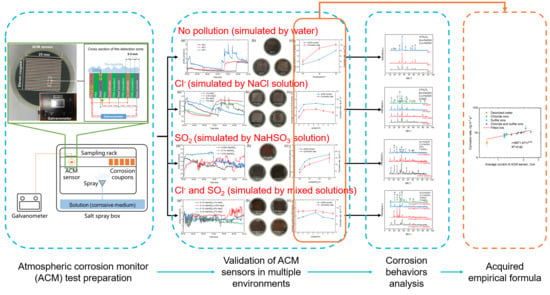Investigation of Corrosion Behaviors on an Fe/Cu-Type ACM Sensor under Various Environments
Abstract
1. Introduction
2. Experimental Procedures
2.1. ACM Technology
2.2. Laboratory Test Methods
2.3. Analytical Methods
3. Results and Discussion
3.1. Effect of Temperature
3.2. Effect of Chlorine Ions
3.3. Effect of Hydrosulfite Ions
3.4. Effect of Combined Ionic Contaminants
3.5. Correlation between the ACM Current and Corrosion Rate
4. Conclusions
Author Contributions
Funding
Acknowledgments
Conflicts of Interest
References
- Li, X.; Zhang, D.; Liu, Z.; Li, Z.; Du, C.; Dong, C. Materials science: Share corrosion data. Nature 2015, 527, 441–442. [Google Scholar] [CrossRef] [PubMed]
- Grøntoft, T.; Verney-Carron, A.; Tidblad, J. Cleaning costs for European sheltered white painted steel and modern glass surfaces due to air pollution since the year 2000. Atmosphere 2019, 10, 167. [Google Scholar] [CrossRef]
- Javaherdashti, R. How corrosion affects industry and life. Anti-Corros. Methods Mater. 2000, 47, 30–34. [Google Scholar] [CrossRef]
- Shi, Y.; Yang, B.; Liaw, P.K. Corrosion-Resistant High-Entropy Alloys: A Review. Metals 2017, 7, 43. [Google Scholar] [CrossRef]
- Azmat, N.S.; Ralston, K.D.; Muddle, B.C.; Cole, I.S. Corrosion of Zn under acidified marine droplets. Corros. Sci. 2011, 53, 1604–1615. [Google Scholar] [CrossRef]
- Thierry, D.; LeBozec, N. Corrosion products formed on confined hot-dip galvanized steel in accelerated cyclic corrosion tests. Corrosion 2009, 65, 718–725. [Google Scholar] [CrossRef]
- Veleva, L.; Pérez, G.; Acosta, M. Statistical analysis of the temperature-humidity complex and time of wetness of a tropical climate in the Yucatan Peninsula in Mexico. Atmos. Environ. 1997, 31, 773–776. [Google Scholar] [CrossRef]
- Boelen, B.; Schmitz, B.; Defourny, J.; Blekkenhorst, F. A literature survey on the development of an accelerated laboratory test method for atmospheric corrosion of precoated steel products. Corros. Sci. 1993, 34, 1923–1931. [Google Scholar] [CrossRef]
- Institute, T.B.S. Corrosion of metals and alloys—Corrosivity of atmospheres—Classification, determination and estimation. In ISO 9223: 2012; The British Standard Institute: London, UK; European Committee for Standardization: Brussels, Belgium, 2012. [Google Scholar]
- Zhi, Y.; Fu, D.; Zhang, D.; Yang, T.; Li, X. Prediction and Knowledge Mining of Outdoor Atmospheric Corrosion Rates of Low Alloy Steels Based on the Random Forests Approach. Metals 2019, 9, 383. [Google Scholar] [CrossRef]
- Purwasih, N.; Kasai, N.; Okazaki, S.; Kihira, H. Development of Amplifier Circuit by Active-Dummy Method for Atmospheric Corrosion Monitoring in Steel Based on Strain Measurement. Metals 2018, 8, 5. [Google Scholar] [CrossRef]
- Purwasih, N.; Kasai, N.; Okazaki, S.; Kihira, H.; Kuriyama, Y. Atmospheric Corrosion Sensor Based on Strain Measurement with an Active Dummy Circuit Method in Experiment with Corrosion Products. Metals 2019, 9, 579. [Google Scholar] [CrossRef]
- Shi, Y.; Fu, D.; Zhou, X.; Yang, T.; Zhi, Y.; Pei, Z.; Zhang, D.; Shao, L. Data mining to online galvanic current of zinc/copper Internet atmospheric corrosion monitor. Corros. Sci. 2018, 133, 443–450. [Google Scholar] [CrossRef]
- Pei, Z.; Cheng, X.; Yang, X.; Li, Q.; Xia, C.; Zhang, D.; Li, X. Understanding environmental impacts on initial atmospheric corrosion based on corrosion monitoring sensors. J. Mater. Sci. Technol. 2020. [Google Scholar] [CrossRef]
- Nishikata, A.; Zhu, Q.; Tada, E. Long-term monitoring of atmospheric corrosion at weathering steel bridges by an electrochemical impedance method. Corros. Sci. 2014, 87, 80–88. [Google Scholar] [CrossRef]
- Yadav, A.P.; Suzuki, F.; Nishikata, A.; Tsuru, T. Investigation of atmospheric corrosion of Zn using ac impedance and differential pressure meter. Electrochim. Acta 2004, 49, 2725–2729. [Google Scholar] [CrossRef]
- Thee, C.; Hao, L.; Dong, J.; Mu, X.; Wei, X.; Li, X.; Ke, W. Atmospheric corrosion monitoring of a weathering steel under an electrolyte film in cyclic wet–dry condition. Corros. Sci. 2014, 78, 130–137. [Google Scholar] [CrossRef]
- Kamsu-Foguem, B. Knowledge-based support in Non-Destructive Testing for health monitoring of aircraft structures. Adv. Eng. Inform. 2012, 26, 859–869. [Google Scholar] [CrossRef]
- Li, Z.; Fu, D.; Li, Y.; Wang, G.; Meng, J.; Zhang, D.; Yang, Z.; Ding, G.; Zhao, J. Application of An Electrical Resistance Sensor-Based Automated Corrosion Monitor in the Study of Atmospheric Corrosion. Materials 2019, 12, 1065. [Google Scholar] [CrossRef] [PubMed]
- Mansfeld, F.; Kenkel, J.V. Electrochemical monitoring of atmospheric corrosion phenomena. Corros. Sci. 1976, 16, 111–122. [Google Scholar] [CrossRef]
- Mizuno, D.; Suzuki, S.; Fujita, S.; Hara, N. Corrosion monitoring and materials selection for automotive environments by using Atmospheric Corrosion Monitor (ACM) sensor. Corros. Sci. 2014, 83, 217–225. [Google Scholar] [CrossRef]
- Pongsaksawad, W.; Viyanit, E.; Sorachot, S.; Shinohara, T. Corrosion assessment of carbon steel in Thailand by atmospheric corrosion monitoring (ACM) sensors. J. Met. Mater. Miner. 2010, 20, 23–27. [Google Scholar]
- Pei, Z.; Zhang, D.; Zhi, Y.; Yang, T.; Jin, L.; Fu, D.; Cheng, X.; Terryn, H.A.; Mol, J.M.C.; Li, X. Towards understanding and prediction of atmospheric corrosion of an Fe/Cu corrosion sensor via machine learning. Corros. Sci. 2020, 170, 108697. [Google Scholar] [CrossRef]
- Liu, Q.; Luo, H.; Dong, C.F.; Xiao, K.; Li, X.G. The electrochemical behavior of brass in NaHSO3 solution without and with Cl. Int. J. Electrochem. Sci. 2012, 7, 11123–11136. [Google Scholar]
- Cheng, X.; Jin, Z.; Liu, M.; Li, X. Optimizing the nickel content in weathering steels to enhance their corrosion resistance in acidic atmospheres. Corros. Sci. 2017, 115, 135–142. [Google Scholar] [CrossRef]
- Qian, H.; Zhang, D.; Lou, Y.; Li, Z.; Xu, D.; Du, C.; Li, X. Laboratory investigation of microbiologically influenced corrosion of Q235 carbon steel by halophilic archaea Natronorubrum tibetense. Corros. Sci. 2018, 145, 151–161. [Google Scholar] [CrossRef]
- Qiu, L.-G.; Wu, Y.; Wang, Y.-M.; Jiang, X. Synergistic effect between cationic gemini surfactant and chloride ion for the corrosion inhibition of steel in sulphuric acid. Corros. Sci. 2008, 50, 576–582. [Google Scholar] [CrossRef]
- Soltis, J.; Laycock, N.J.; Krouse, D. Temperature dependence of the pitting potential of high purity aluminium in chloride containing solutions. Corros. Sci. 2011, 53, 7–10. [Google Scholar] [CrossRef]
- Prosek, T.; Nazarov, A.; Stoulil, J.; Thierry, D. Evaluation of the tendency of coil-coated materials to blistering: Field exposure, accelerated tests and electrochemical measurements. Corros. Sci. 2012, 61, 92–100. [Google Scholar] [CrossRef]
- Ma, Y.; Li, Y.; Wang, F. Corrosion of low carbon steel in atmospheric environments of different chloride content. Corros. Sci. 2009, 51, 997–1006. [Google Scholar] [CrossRef]
- Morcillo, M.; Chico, B.; Díaz, I.; Cano, H.; Fuente, D.D.L. Atmospheric corrosion data of weathering steels. A review. Corros. Sci. 2013, 77, 6–24. [Google Scholar] [CrossRef]
- Alcántara, J.; Chico, B.; Díaz, I.; Fuente, D.D.L.; Morcillo, M. Airborne chloride deposit and its effect on marine atmospheric corrosion of mild steel. Corros. Sci. 2015, 97, 74–88. [Google Scholar]
- Krivy, V.; Kubzova, M.; Kreislova, K.; Urban, V. Characterization of Corrosion Products on Weathering Steel Bridges Influenced by Chloride Deposition. Metals 2017, 7, 336. [Google Scholar] [CrossRef]
- Mi, N.; Ghahari, M.; Rayment, T.; Davenport, A.J. Use of inkjet printing to deposit magnesium chloride salt patterns for investigation of atmospheric corrosion of 304 stainless steel. Corros. Sci. 2011, 53, 3114–3121. [Google Scholar] [CrossRef]
- Weissenrieder, J.; Leygraf, C. In situ studies of filiform corrosion of iron. J. Electrochem. Soc. 2004, 151, B165–B171. [Google Scholar] [CrossRef]
- Qu, Q.; Yan, C.W.; Zhang, L.; Wan, Y.; Cao, C.N. Influence of Nacl Deposition on Atmospheric Corrosion of A3 Steel in the Presence of SO2. Acta Metall. Sin. Engl. Lett. 2002, 15, 409–415. [Google Scholar]
- Liu, S.; Sun, H.; Sun, L.; Fan, H. Effects of pH and Cl− concentration on corrosion behavior of the galvanized steel in simulated rust layer solution. Corros. Sci. 2012, 65, 520–527. [Google Scholar] [CrossRef]
- Sudakar, C.; Subbanna, G.N.; Kutty, T.R.N. Effect of anions on the phase stability of γ-FeOOH nanoparticles and the magnetic properties of gamma-ferric oxide derived from lepidocrocite. J. Phys. Chem. Solids 2003, 64, 2337–2349. [Google Scholar] [CrossRef]
- Wang, Z.; Liu, J.; Wu, L.; Han, R.; Sun, Y. Study of the corrosion behavior of weathering steels in atmospheric environments. Corros. Sci. 2013, 67, 1–10. [Google Scholar] [CrossRef]
- Okonkwo, P.C.; Shakoor, R.A.; Benamor, A.; Mohamed, A.M.A.; Al-Marri, M.J.F.A. Corrosion Behavior of API X100 Steel Material in a Hydrogen Sulfide Environment. Metals 2017, 7, 109. [Google Scholar] [CrossRef]
- Wang, J.H.; Wei, F.I.; Chang, Y.; Shih, H.C. The corrosion mechanisms of carbon steel and weathering steel in SO2 polluted atmospheres. Mater. Chem. Phys. 1997, 47, 1–8. [Google Scholar] [CrossRef]
- Misawa, T.; Asami, K.; Hashimoto, K.; Shimodaira, S. The mechanism of atmospheric rusting and the protective amorphous rust on low alloy steel. Corros. Sci. 1974, 14, 279–289. [Google Scholar] [CrossRef]
- Cao, X.; Xu, C. Synergistic effect of chloride and sulfite ions on the atmospheric corrosion of bronze. Mater. Corros. 2006, 57, 400–406. [Google Scholar] [CrossRef]
- Knotkova, D.; Dean, S.W.; Kreislova, K. International Atmospheric Exposure Program: Summary of Results: Developed by ISO/TC 156/WG 4, Atmospheric Corrosion Testing and Classification of Corrosivity of Atmosphere; ASTM International: West Conshohocken, PA, USA, 2010; pp. 10–65. [Google Scholar]
- Guskos, N.; Papadopoulos, G.J.; Likodimos, V.; Patapis, S.; Yarmis, D.; Przepiera, A.; Przepiera, K.; Majszczyk, J.; Typek, J.; Wabia, M.; et al. Photoacoustic, EPR and electrical conductivity investigations of three synthetic mineral pigments: Hematite, goethite and magnetite. Mater. Res. Bull. 2002, 37, 1051–1061. [Google Scholar] [CrossRef]
- Jagannadha Sarma, V.V.; Subba Rao, C. Electrical conductivity of rain water at Visakhapatnam, India. J. Geophys. Res. 1972, 77, 2197–2200. [Google Scholar] [CrossRef]
- Hermans, T.; Paepen, M. Combined Inversion of Land and Marine Electrical Resistivity Tomography for Submarine Groundwater Discharge and Saltwater Intrusion Characterization. Geophys. Res. Lett. 2020, 47, e2019GL085877. [Google Scholar] [CrossRef]
- Habib, K. Measurement of surface resistivity/conductivity of carbon steel in 5–20 ppm of KGR-134 inhibited seawater by holographic interferometry techniques. In Optical Measurement Systems for Industrial Inspection VII, Proceedings of the SPIE—International Society for Optics and Photonics, Munich, Germany, 23–26 May 2011; Peter, L., Ed.; Curran Associates: Manila, Philippines, 2011. [Google Scholar]
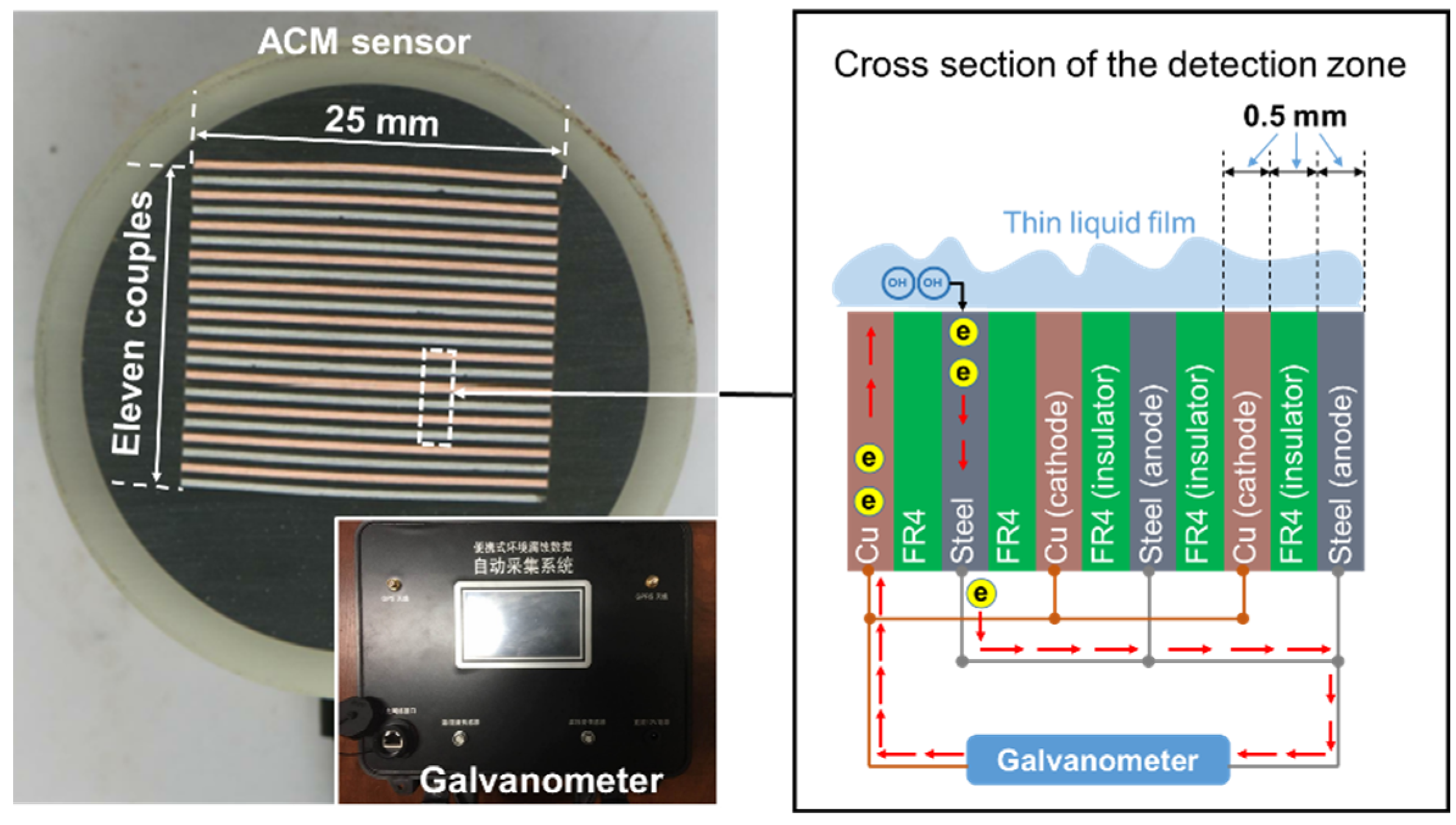
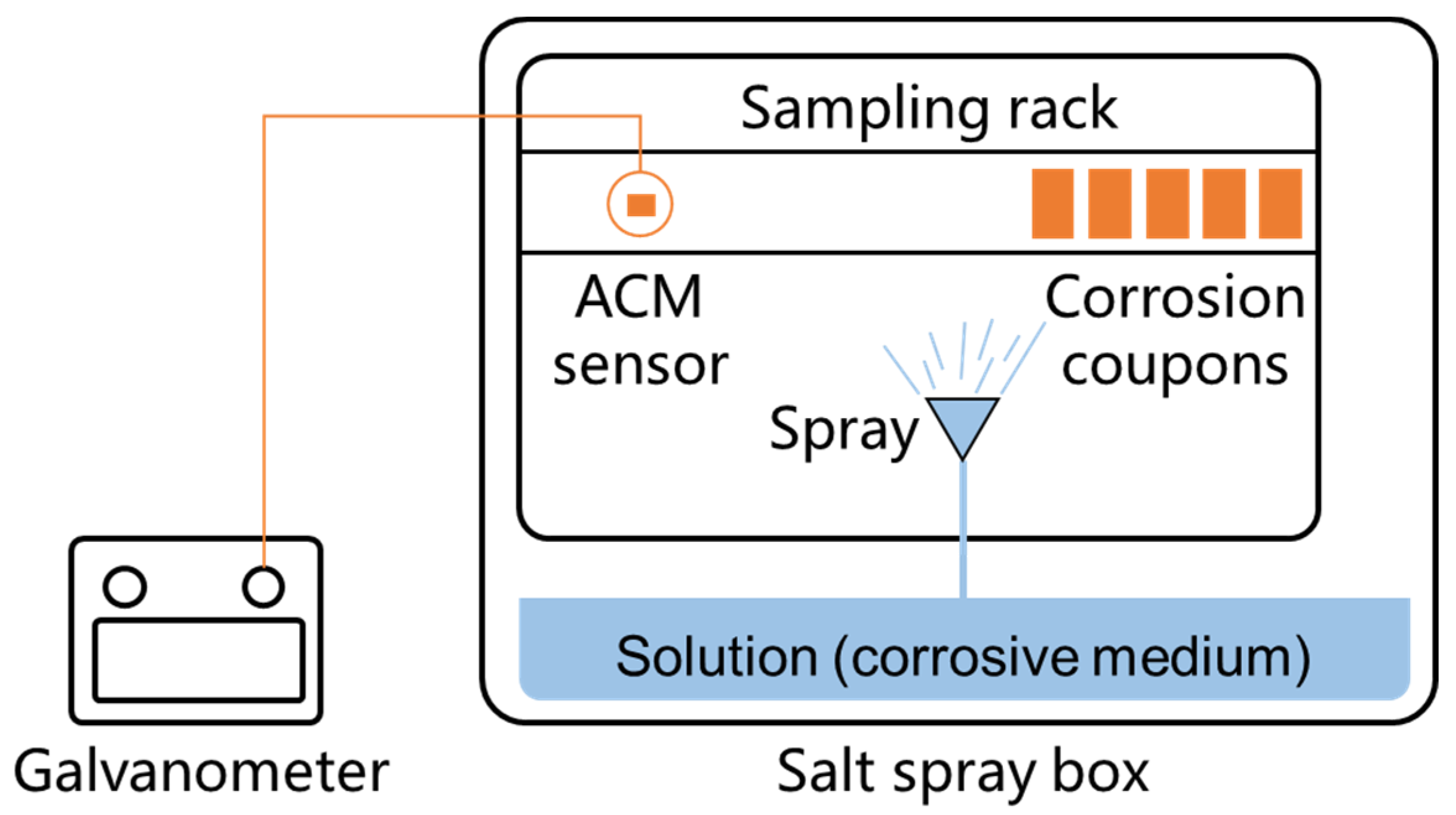

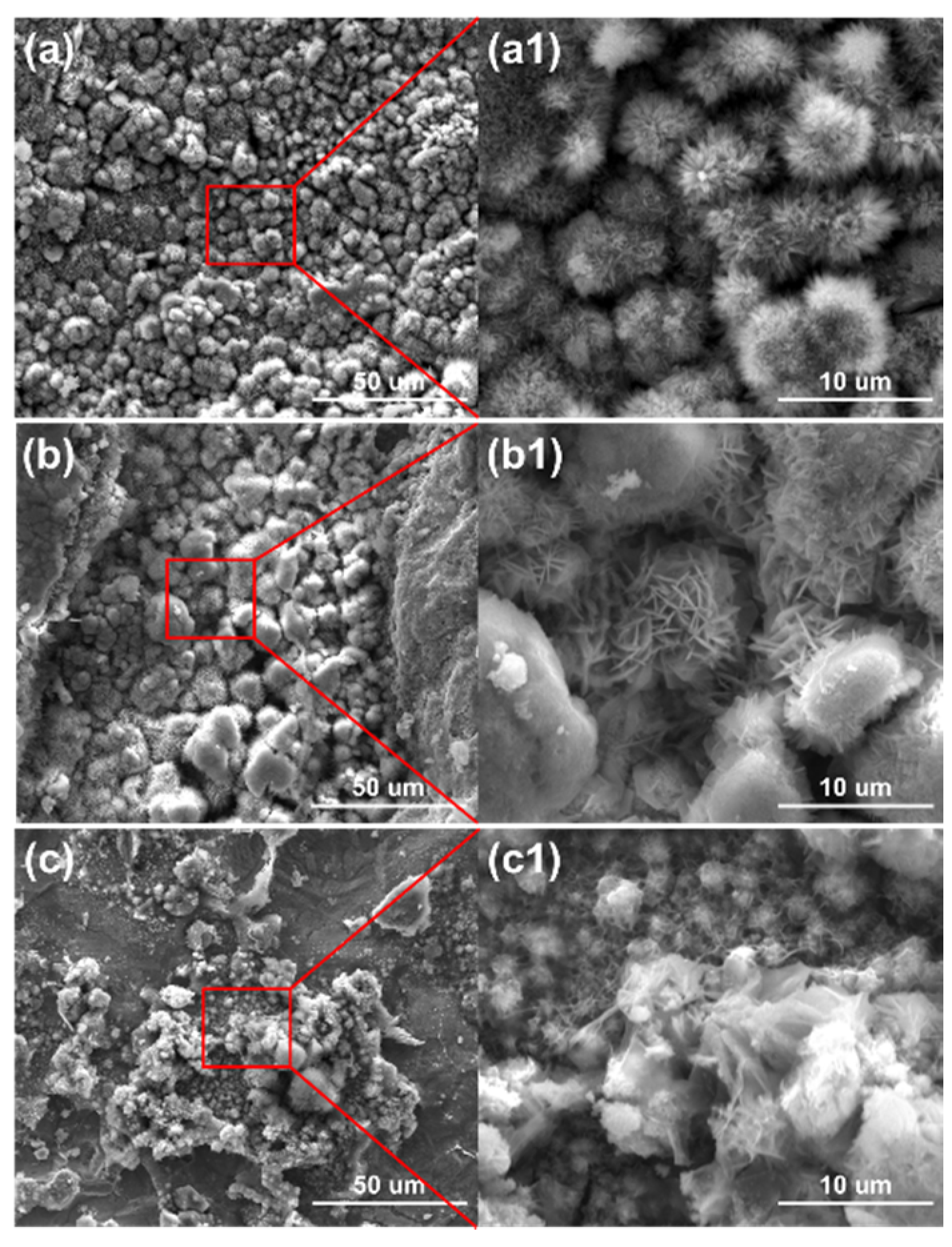
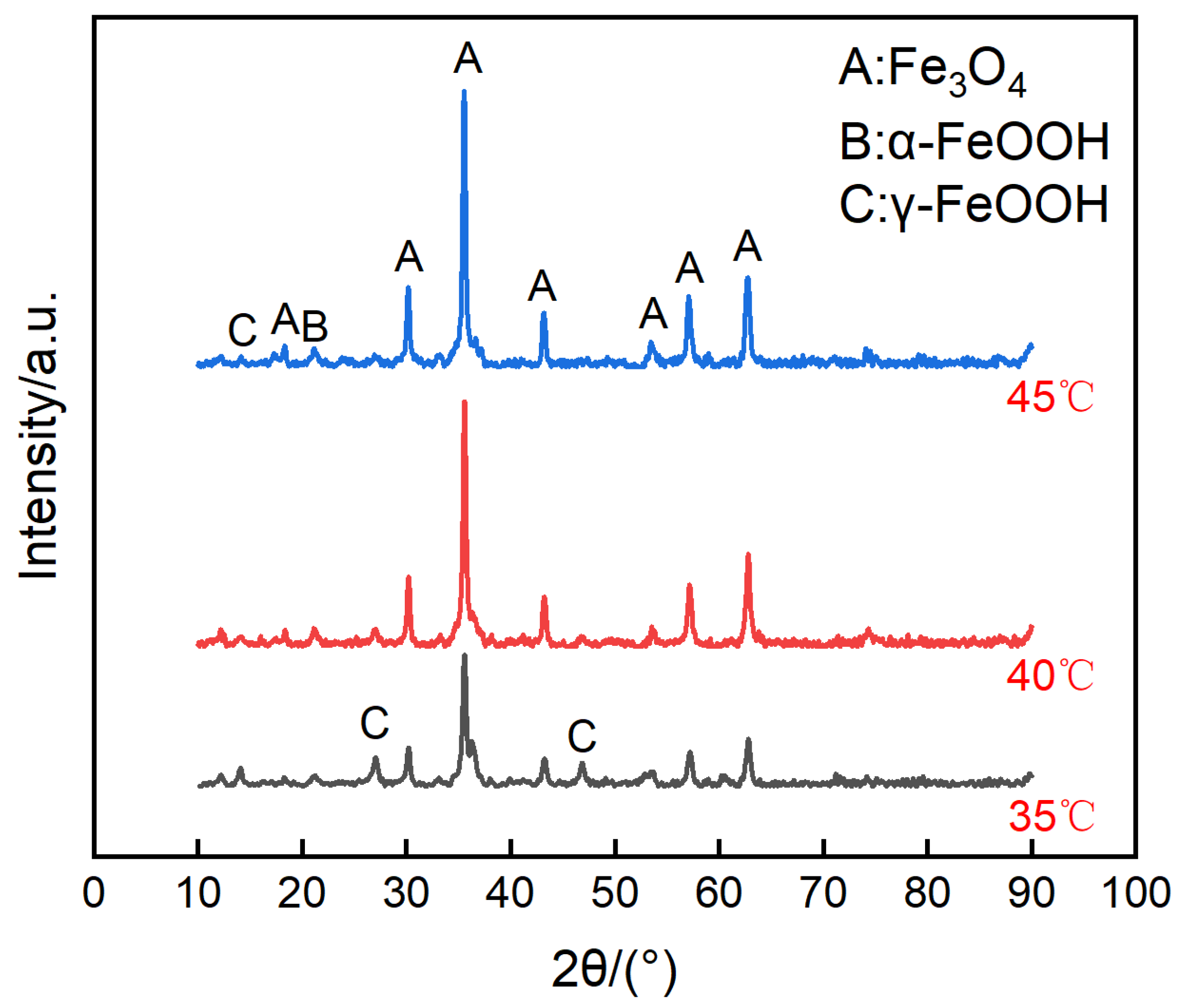

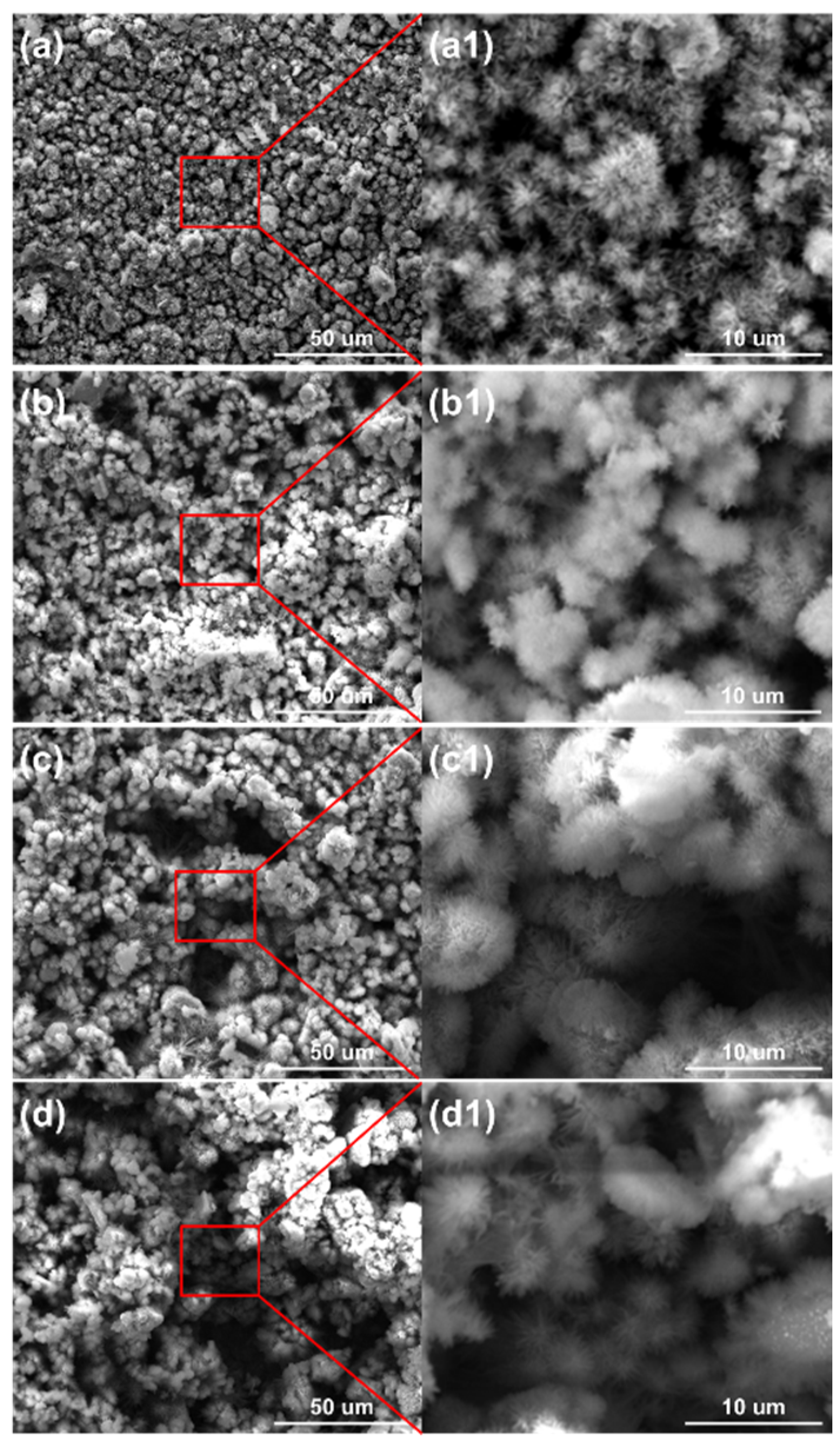
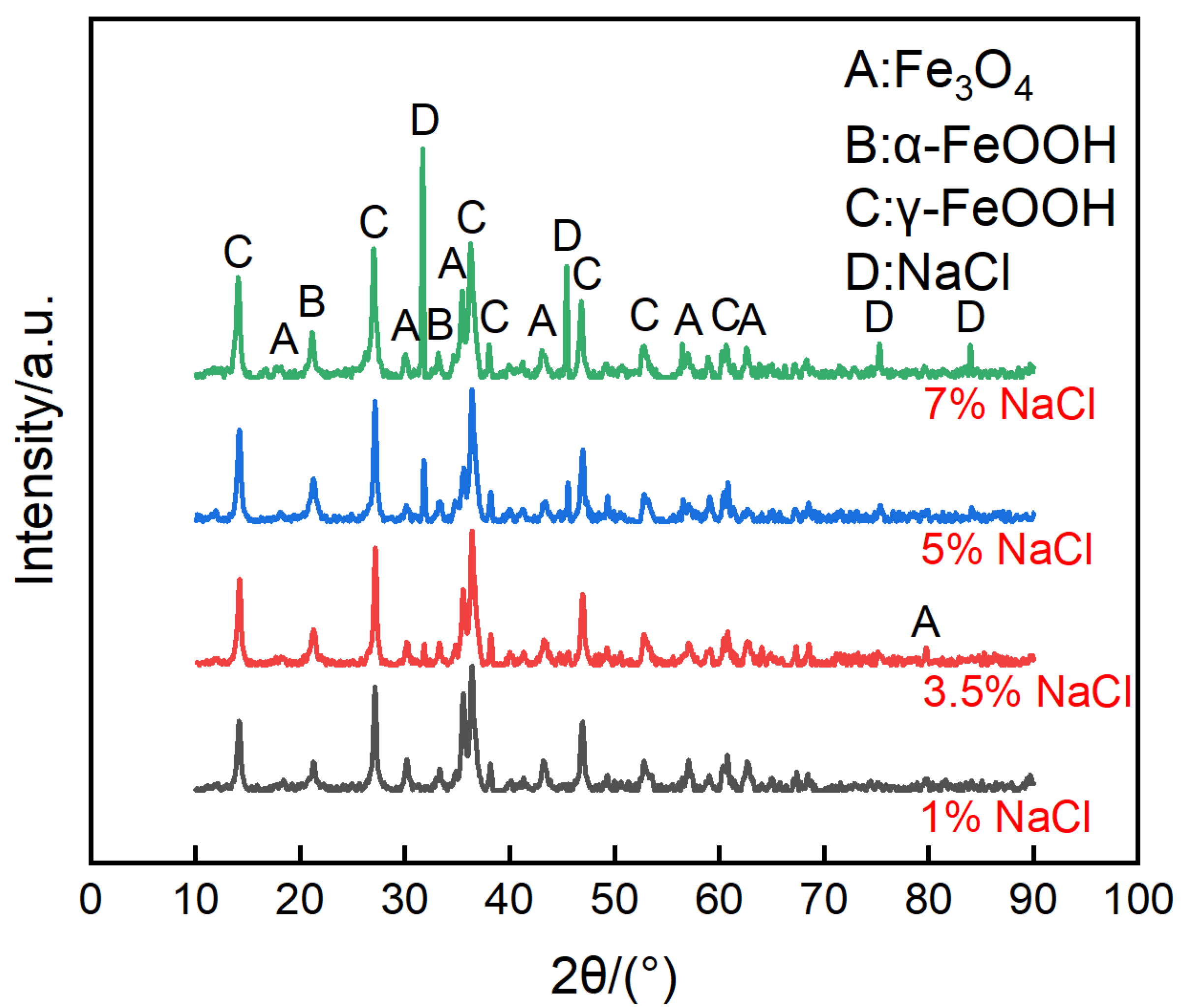

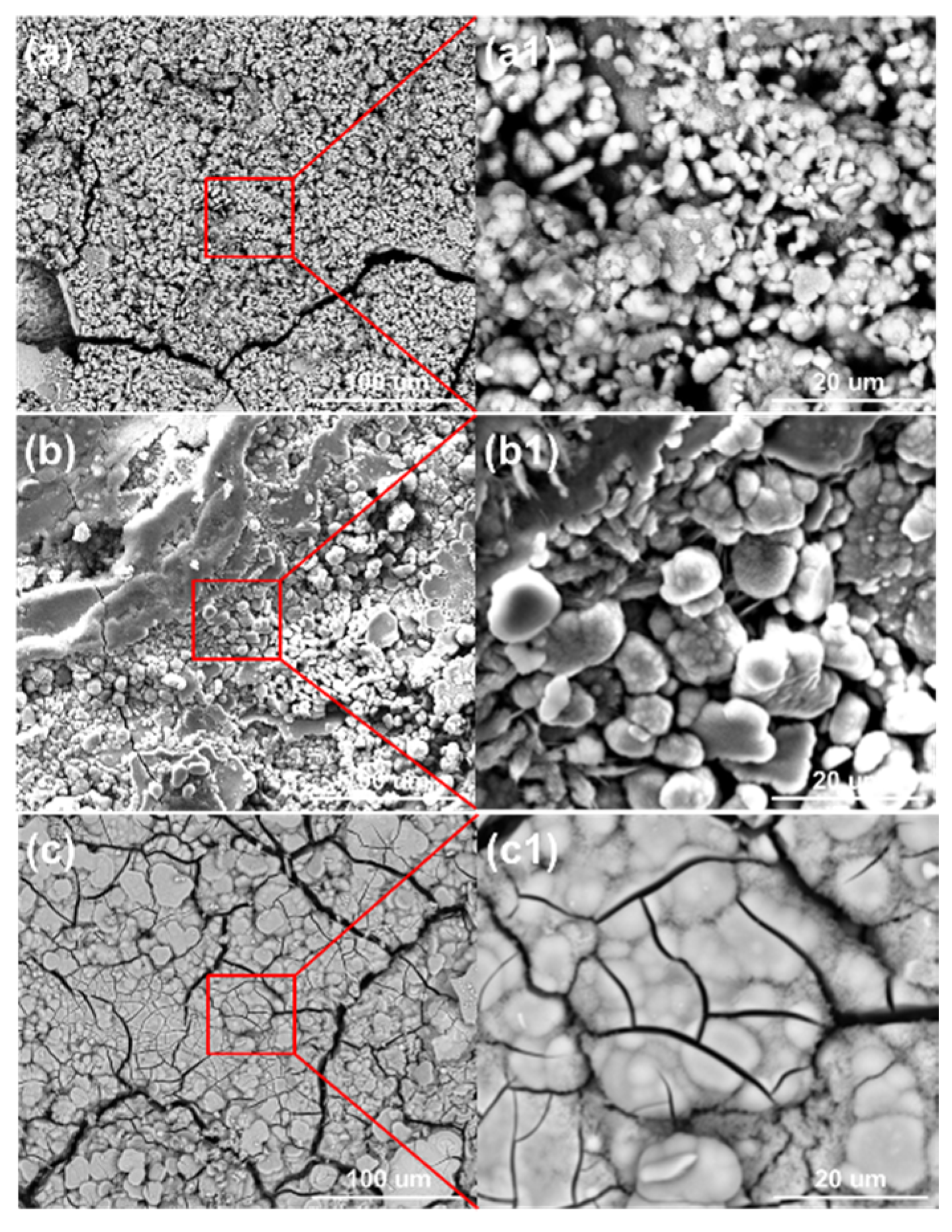
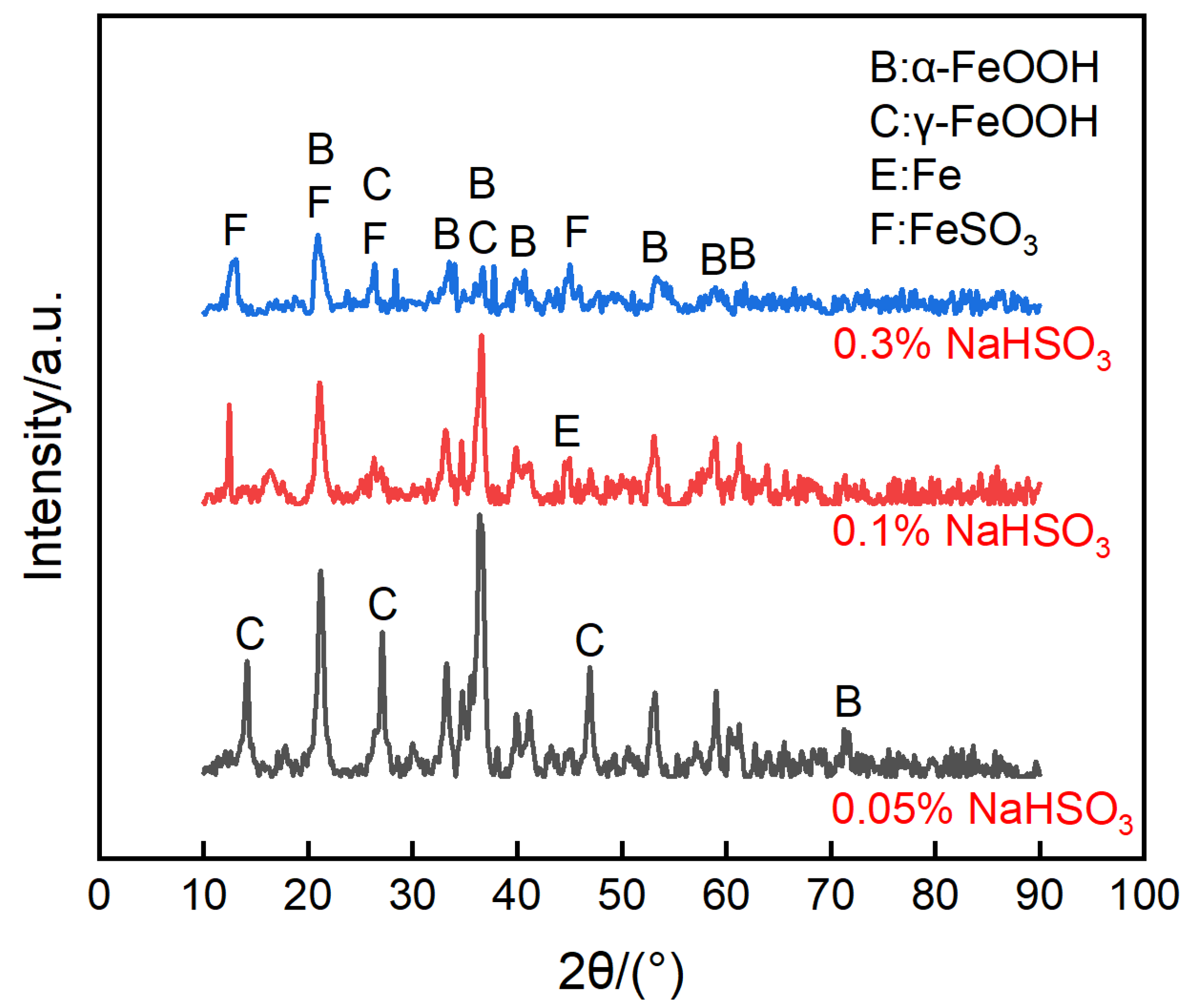

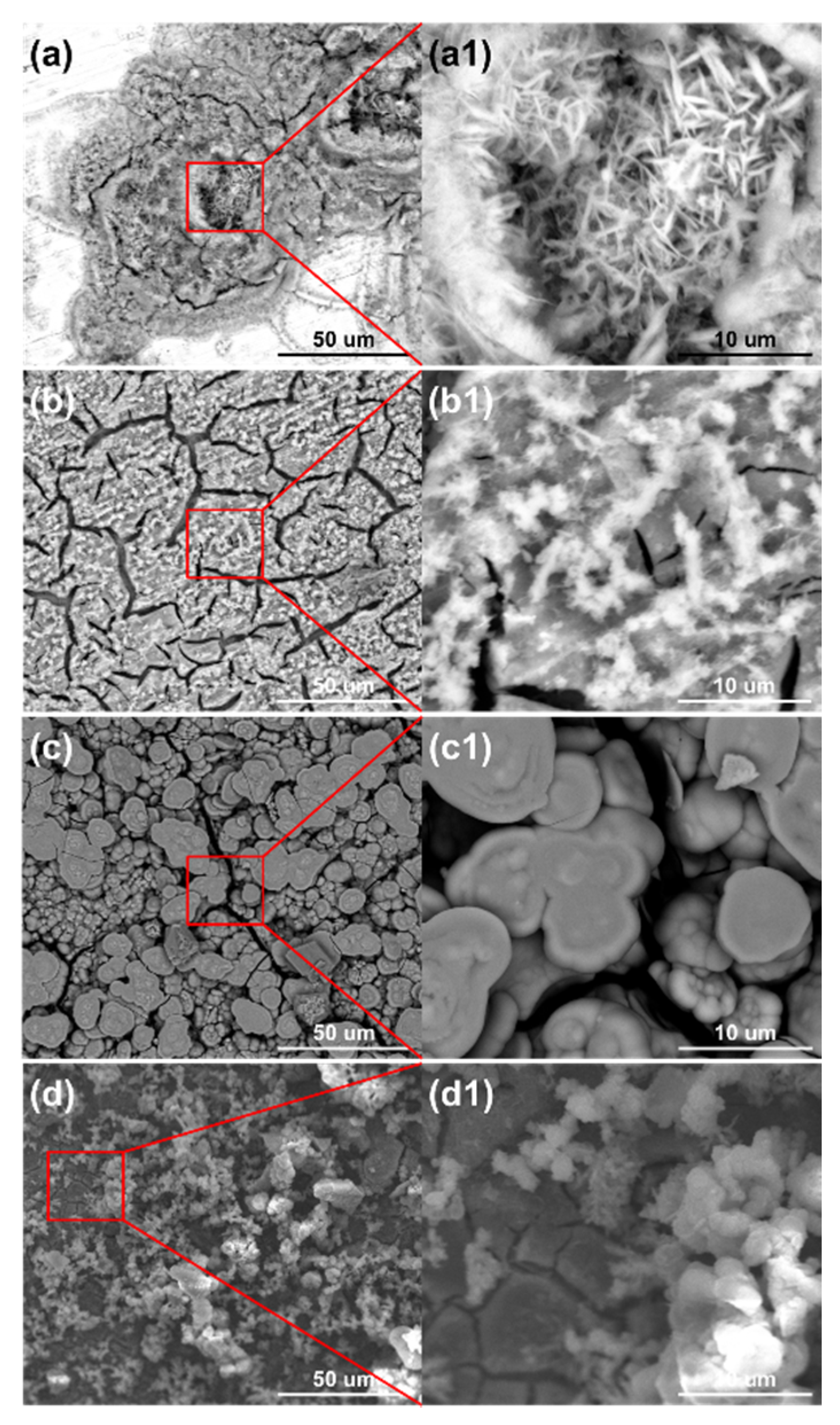
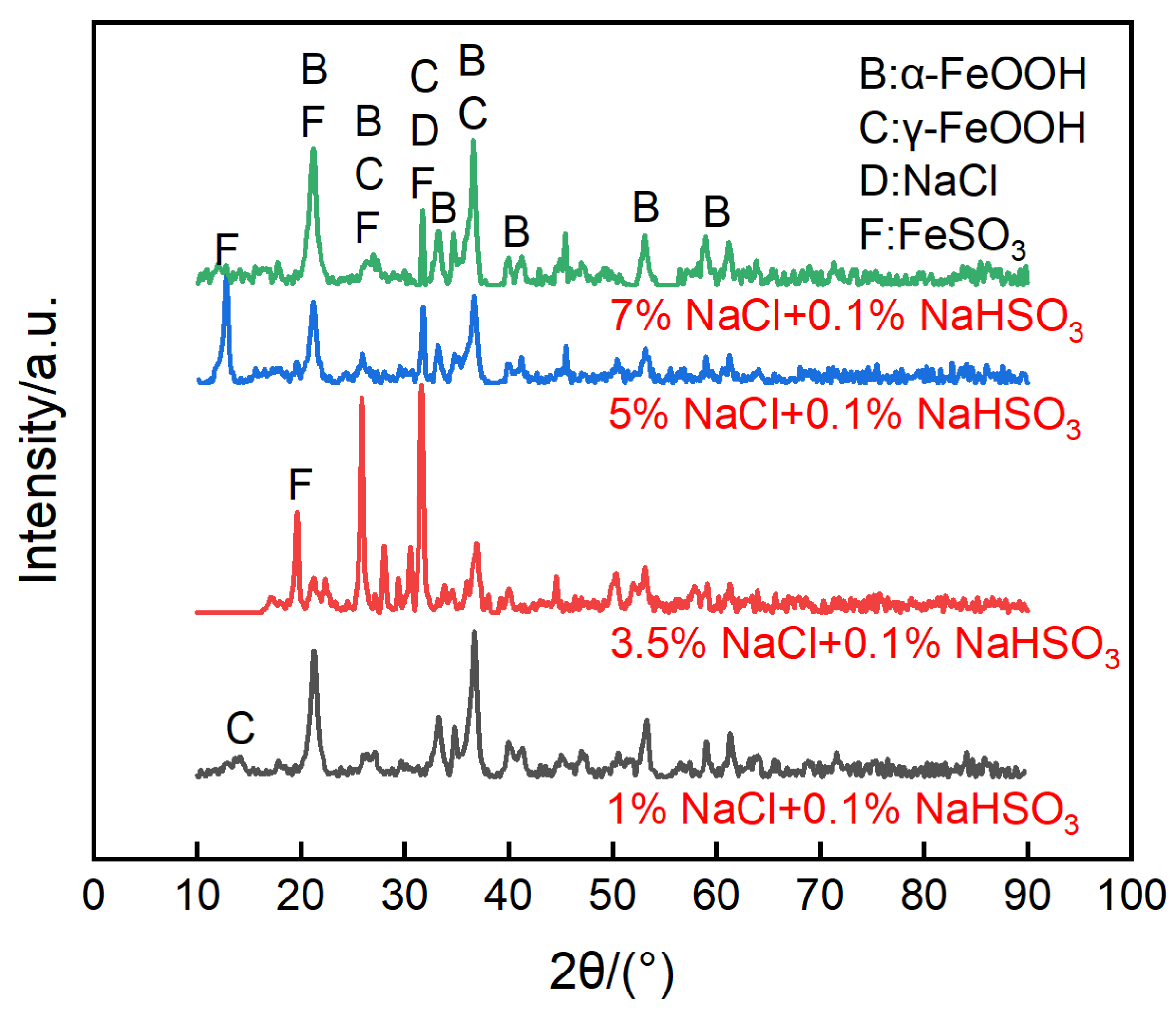
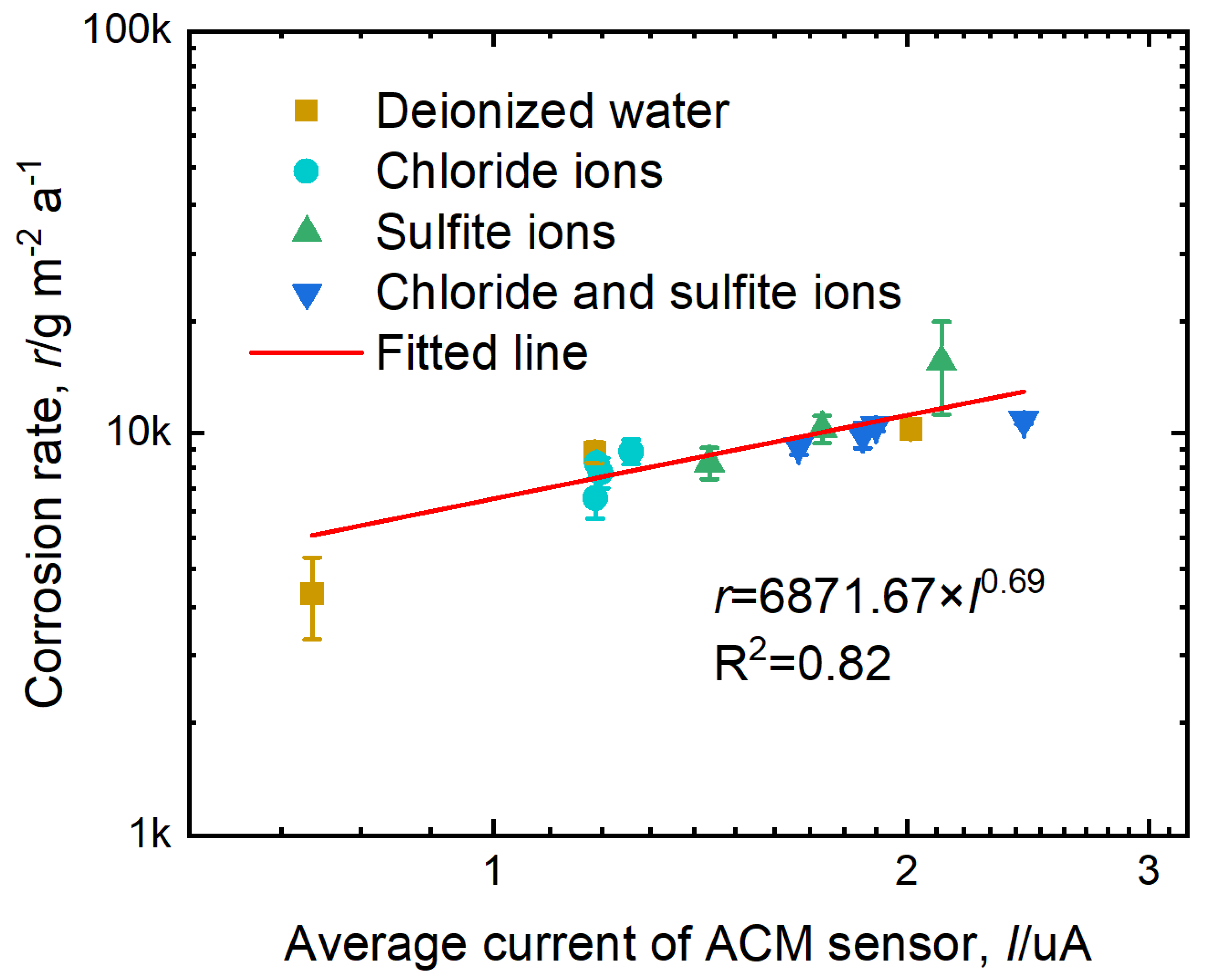
| Materials | C | Si | Mn | S | P | Nb | Ni | Cr | Fe |
|---|---|---|---|---|---|---|---|---|---|
| Q235 | 0.16 | 0.08 | 0.30 | 0.02 | 0.01 | 0.01 | <0.01 | 0.02 | In balance |
| Simulated Environment | Electrolyte Type and Concentration Gradient | Electrolyte Temperature |
|---|---|---|
| Pure atmosphere | Deionized water | 35 °C/40 °C/45 °C |
| Chloride ions | 1%/3.5%/5%/7% (NaCl) | 35 °C |
| Sulfur dioxide | 0.05%/0.1%/0.3%/0.5% (NaHSO3) | 35 °C |
| Combined pollutants | 0.05%/0.1%/0.3%/0.5% (NaCl) + 0.1% (NaHSO3) | 35 °C |
© 2020 by the authors. Licensee MDPI, Basel, Switzerland. This article is an open access article distributed under the terms and conditions of the Creative Commons Attribution (CC BY) license (http://creativecommons.org/licenses/by/4.0/).
Share and Cite
Pei, Z.; Xiao, K.; Chen, L.; Li, Q.; Wu, J.; Ma, L.; Li, X. Investigation of Corrosion Behaviors on an Fe/Cu-Type ACM Sensor under Various Environments. Metals 2020, 10, 905. https://doi.org/10.3390/met10070905
Pei Z, Xiao K, Chen L, Li Q, Wu J, Ma L, Li X. Investigation of Corrosion Behaviors on an Fe/Cu-Type ACM Sensor under Various Environments. Metals. 2020; 10(7):905. https://doi.org/10.3390/met10070905
Chicago/Turabian StylePei, Zibo, Kui Xiao, Lihong Chen, Qing Li, Jun Wu, Lingwei Ma, and Xiaogang Li. 2020. "Investigation of Corrosion Behaviors on an Fe/Cu-Type ACM Sensor under Various Environments" Metals 10, no. 7: 905. https://doi.org/10.3390/met10070905
APA StylePei, Z., Xiao, K., Chen, L., Li, Q., Wu, J., Ma, L., & Li, X. (2020). Investigation of Corrosion Behaviors on an Fe/Cu-Type ACM Sensor under Various Environments. Metals, 10(7), 905. https://doi.org/10.3390/met10070905



